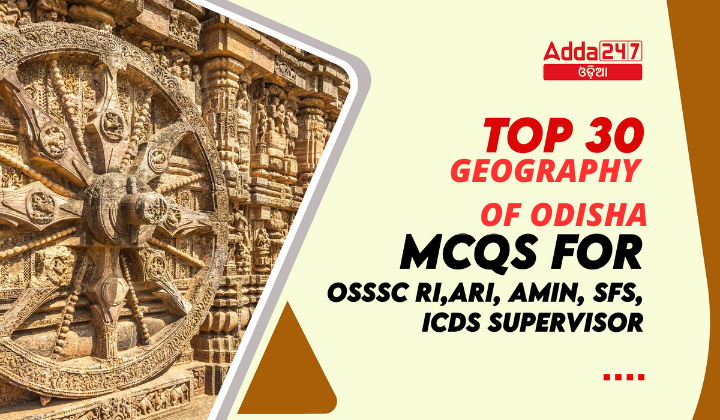For candidates preparing for the Odisha Sub-ordinate Staff Selection Commission (OSSSC) recruitment exams, mastering the geography of Odisha is essential. This set of top 30 multiple-choice questions (MCQs) covers a range of topics including the physical geography, climate, rivers, mountains, forests, and mineral resources of Odisha. These questions are designed to help you understand the unique geographical features of the state and how they influence the region’s economy and culture.
Top 30 Geography of Odisha MCQs For OSSSC RI,ARI, Amin, SFS, ICDS Supervisor
- Which region of Odisha is known as the “Rice Bowl” of the state due to its fertility?
A) The Odisha Coastal Plains in the East
B) The Middle Mountainous and Highlands Region
C) The Central Plateaus
D) The Western Rolling Uplands
Answer: A) The Odisha Coastal Plains in the East - Which of the following regions in Odisha is the most drought-affected area?
A) Northern Coastal Plains/Balasore Plains
B) Middle Coastal Plains/Cuttack-Puri Coastal Plain
C) Southern Coastal Plains/Rushikulya Plains
D) The Salt Tract
Answer: A) Northern Coastal Plains/Balasore Plains - Which mountain range in Odisha is the highest in the state and is home to the Deomali peak, the highest peak of Odisha?
A) Simlipal and Meghasani Mountains
B) Mankadnacha, Malayagiri, and Gandhamardan Mountains
C) Common Interfluves of the Mahanadi, the Rushikulya, and Vamsadhara
D) Potangi and Chandragiri Mountain Ranges
Answer: D) Potangi and Chandragiri Mountain Ranges - Which plateau in Odisha lies on the Western slopes of the Eastern Ghats and is surrounded by the Singhbhum and Ranchi plateaus in the North?
A) The Panposh-Keonjhar-Pallahara Plateau of the Upper Baitarani Catchment Basin
B) The Nabarangpur-Jayapur of the Upper Sabari Basin
C) The Rajgangpur-Panposh uplands of the Koel and the Sankh rivers
D) The Jharsuguda uplands of the Ib basin
Answer: A) The Panposh-Keonjhar-Pallahara Plateau of the Upper Baitarani Catchment Basin - What is the average elevation range of the River Valleys and Flood Plains in Odisha?
A) 200 to 400 meters
B) 75 to 150 meters
C) 500 to 800 meters
D) 1000 to 1200 meters
Answer: B) 75 to 150 meters - Which lake in Odisha is the deepest natural port of India?
A) Ansupa Lake
B) Sar Lake
C) Chilika Lake
D) Paradeep Port
Answer: D) Paradeep Port - What is the major river that drains the Rajgangpur-Panposh uplands of Odisha?
A) Mahanadi River
B) Brahmani River
C) Sabari River
D) Vamsadhara River
Answer: B) Brahmani River - Which region of Odisha is known for its volcanic origin mountains with dome-shaped and circular structure?
A) Simlipal and Meghasani Mountains
B) Mankadnacha, Malayagiri, and Gandhamardan Mountains
C) Potangi and Chandragiri Mountain Ranges
D) Singaraju, Mahandragiri, and Devagiri Mountain Ranges
Answer: A) Simlipal and Meghasani Mountains - During which season does Odisha experience the highest temperatures, often exceeding 40°C?
A) Rainy Season
B) Winter Season
C) Summer Season
D) Autumn Season
Answer: C) Summer Season - What is the primary cause of rainfall in Odisha during the monsoon season?
A) Western Disturbances
B) Northeast Monsoon
C) Southwest Monsoon
D) Tropical Cyclones
Answer: C) Southwest Monsoon - Which regions of Odisha are characterized by low annual rainfall, typically 135 cm or less?
A) Northern Odisha
B) South-East Odisha
C) Western Odisha
D) Coastal Odisha
Answer: B) South-East Odisha - What is the approximate range of relative humidity experienced in coastal Odisha during the monsoon season?
A) 40% – 50%
B) 60% – 70%
C) 75% – 85%
D) 90% – 100%
Answer: C) 75% – 85% - Which season in Odisha experiences thunder showers in the Southern and Western parts of the state?
A) Summer Season
B) Rainy Season
C) Winter Season
D) Spring Season
Answer: C) Winter Season - What is the local seasonal division in Odisha that corresponds to mid-February to mid-April?
A) Grishma (Summer)
B) Barsa (Rainy season)
C) Basanta (Spring)
D) Sisira (Winter)
Answer: C) Basanta (Spring) - Which climate classification system categorizes Odisha’s climate as tropical savannah type?
A) Koppen’s classification
B) Thornthwaite’s classification
C) SB Chatterjee’s classification
D) Bergeron classification
Answer: A) Koppen’s classification - What is the threshold for considering rainfall in Odisha during the monsoon season as high or low?
A) Above 100 cm is high; below 50 cm is low
B) Above 200 cm is high; below 100 cm is low
C) Above 140 cm is high; below 120 cm is low
D) Above 300 cm is high; below 200 cm is low
Answer: C) Above 140 cm is high; below 120 cm is low - Which region of Odisha experiences the highest temperatures during the summer season?
A) Northern Odisha
B) Coastal Odisha
C) Western Odisha
D) Southern Odisha
Answer: C) Western Odisha - What is the approximate range of temperatures experienced in the coastal areas of Odisha during the winter season?
A) 0°C – 5°C
B) 10°C – 15°C
C) 18°C – 25°C
D) 30°C – 35°C
Answer: C) 18°C – 25°C - Which zone of Odisha is characterized by its hilly terrain and forms a part of the Eastern Ghats?
A) Coastal Plains
B) Central Table Land
C) Northern Plateau
D) Eastern Ghats
Answer: D) Eastern Ghats - Which zone of Odisha consists of relatively flat and elevated areas, forming a central part of the state?
A) Coastal Plains
B) Central Table Land
C) Northern Plateau
D) Eastern Ghats
Answer: B) Central Table Land - Which zone of Odisha includes areas with undulating terrain and forms the northern part of the state?
A) Coastal Plains
B) Central Table Land
C) Northern Plateau
D) Eastern Ghats
Answer: C) Northern Plateau - Which region of Odisha is home to some of the oldest rock formations on the planet, with the second oldest rocks found in Champua, Kendujhar?
A) Coastal Plains
B) Eastern Ghats Granulite Belt
C) North Orissa Craton
D) West Orissa Craton
Answer: C) North Orissa Craton - What geological block in Odisha comprises granite intrusives, banded iron formations, and undeformed volcano-sedimentary assemblages of Archaean to early Proterozoic times?
A) Eastern Ghats Granulite Belt
B) North Orissa Craton
C) West Orissa Craton
D) Gondwana Basin
Answer: B) North Orissa Craton - Which geological block in Odisha is mainly composed of Khondalite formations, charnockites, granites, migmatites, and local pegmatites?
A) Eastern Ghats Granulite Belt
B) North Orissa Craton
C) West Orissa Craton
D) Gondwana Basin
Answer: A) Eastern Ghats Granulite Belt - Which geological belt of Odisha contains deposits ranging from early Permian to Early Cretaceous in age and holds most of the state’s coal deposits?
A) Eastern Ghats Granulite Belt
B) North Orissa Craton
C) West Orissa Craton
D) Gondwana Basin
Answer: D) Gondwana Basin - What type of sediments predominantly make up the East Coast of Odisha, originating in the post-Cretaceous era?
A) Aeolian
B) Marine
C) Laterites
D) All of the above
Answer: D) All of the above - Approximately what percentage of Odisha’s total land area is covered by forests?
A) 20%
B) 30%
C) 37.34%
D) 50%
Answer: C) 37.34% - What type of forests in Odisha have a canopy density of over 70 percent?
A) Very Dense Forests
B) Moderately Dense Cover
C) Open Forests
D) Unclassed Forests
Answer: A) Very Dense Forests - Which part of Odisha is covered mostly by farmlands?
A) Northern Plateau
B) Eastern Ghats Granulite Belt
C) Coastal Plains
D) Western Orissa Craton
Answer: C) Coastal Plains - The fault boundaries separating the geological blocks in Odisha are called:
A) Coastal Faults
B) Regional Faults
C) North Orissa Boundary Fault and West Orissa Boundary Fault
D) Tectonic Faults
Answer: C) North Orissa Boundary Fault and West Orissa Boundary Fault









